Universal Basic Income (UBI): Student Views and Societal Impact Report
VerifiedAdded on 2023/05/22
|18
|5350
|272
Report
AI Summary
This report presents a comprehensive study on student perspectives regarding Universal Basic Income (UBI). The research, conducted through an online survey of 500 UK university students, explores their attitudes towards UBI and its potential implementation for specific groups, such as those experiencing poverty or with disabilities. The study investigates how views vary based on social characteristics like age, gender, and education. The report includes a literature review examining existing research on UBI, its definition, and its impact on students, including its effects on education access, financial stress, labor market participation, and entrepreneurship. The methodology section details the research design, participants, survey instrument, data analysis, and encountered problems during data collection, such as low response rates and potential biases. The findings reveal that students generally hold positive views towards UBI, supporting its implementation. The report concludes with recommendations for further research on UBI and its potential societal impacts.

Universal Basic Income (UBI)
1
1
Paraphrase This Document
Need a fresh take? Get an instant paraphrase of this document with our AI Paraphraser
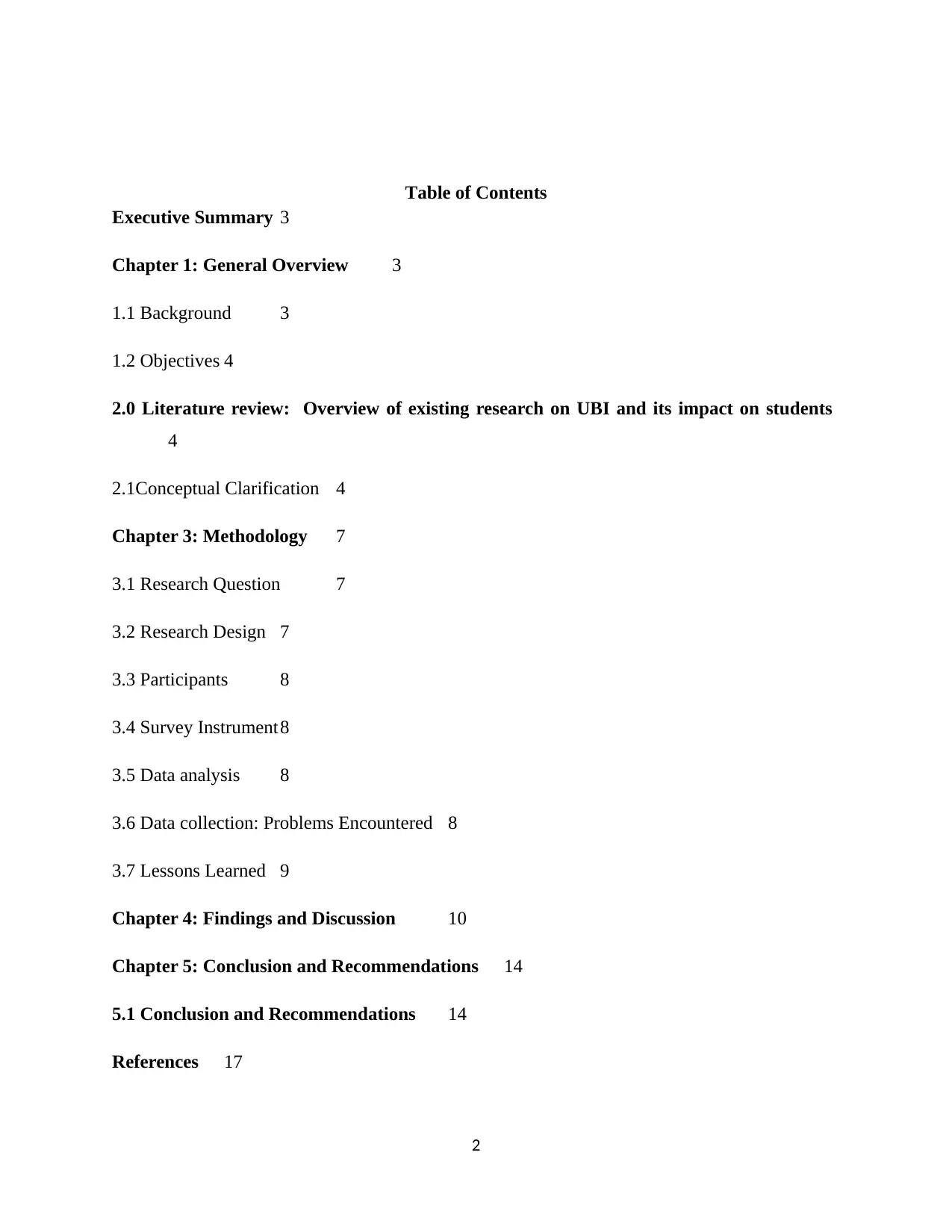
Table of Contents
Executive Summary 3
Chapter 1: General Overview 3
1.1 Background 3
1.2 Objectives 4
2.0 Literature review: Overview of existing research on UBI and its impact on students
4
2.1Conceptual Clarification 4
Chapter 3: Methodology 7
3.1 Research Question 7
3.2 Research Design 7
3.3 Participants 8
3.4 Survey Instrument8
3.5 Data analysis 8
3.6 Data collection: Problems Encountered 8
3.7 Lessons Learned 9
Chapter 4: Findings and Discussion 10
Chapter 5: Conclusion and Recommendations 14
5.1 Conclusion and Recommendations 14
References 17
2
Executive Summary 3
Chapter 1: General Overview 3
1.1 Background 3
1.2 Objectives 4
2.0 Literature review: Overview of existing research on UBI and its impact on students
4
2.1Conceptual Clarification 4
Chapter 3: Methodology 7
3.1 Research Question 7
3.2 Research Design 7
3.3 Participants 8
3.4 Survey Instrument8
3.5 Data analysis 8
3.6 Data collection: Problems Encountered 8
3.7 Lessons Learned 9
Chapter 4: Findings and Discussion 10
Chapter 5: Conclusion and Recommendations 14
5.1 Conclusion and Recommendations 14
References 17
2
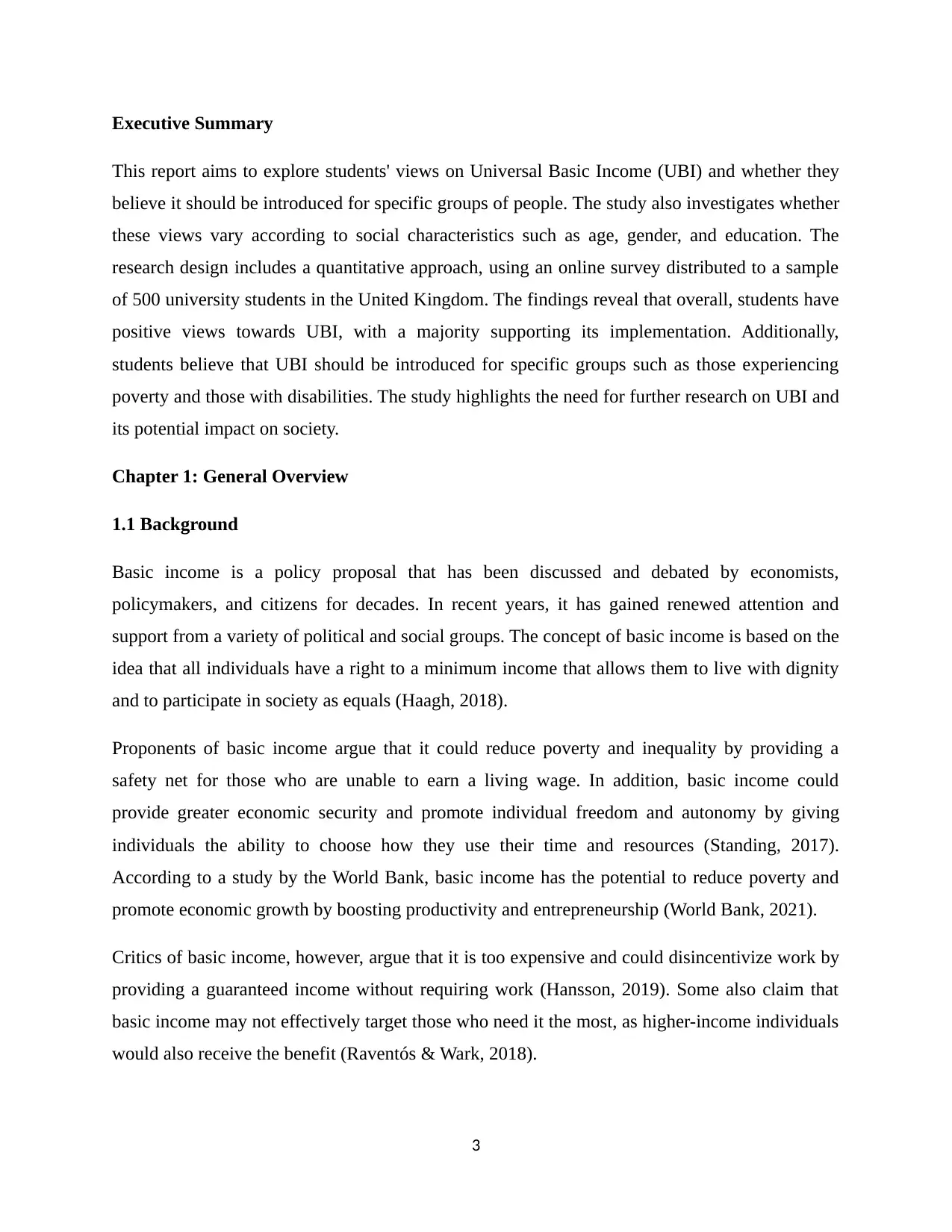
Executive Summary
This report aims to explore students' views on Universal Basic Income (UBI) and whether they
believe it should be introduced for specific groups of people. The study also investigates whether
these views vary according to social characteristics such as age, gender, and education. The
research design includes a quantitative approach, using an online survey distributed to a sample
of 500 university students in the United Kingdom. The findings reveal that overall, students have
positive views towards UBI, with a majority supporting its implementation. Additionally,
students believe that UBI should be introduced for specific groups such as those experiencing
poverty and those with disabilities. The study highlights the need for further research on UBI and
its potential impact on society.
Chapter 1: General Overview
1.1 Background
Basic income is a policy proposal that has been discussed and debated by economists,
policymakers, and citizens for decades. In recent years, it has gained renewed attention and
support from a variety of political and social groups. The concept of basic income is based on the
idea that all individuals have a right to a minimum income that allows them to live with dignity
and to participate in society as equals (Haagh, 2018).
Proponents of basic income argue that it could reduce poverty and inequality by providing a
safety net for those who are unable to earn a living wage. In addition, basic income could
provide greater economic security and promote individual freedom and autonomy by giving
individuals the ability to choose how they use their time and resources (Standing, 2017).
According to a study by the World Bank, basic income has the potential to reduce poverty and
promote economic growth by boosting productivity and entrepreneurship (World Bank, 2021).
Critics of basic income, however, argue that it is too expensive and could disincentivize work by
providing a guaranteed income without requiring work (Hansson, 2019). Some also claim that
basic income may not effectively target those who need it the most, as higher-income individuals
would also receive the benefit (Raventós & Wark, 2018).
3
This report aims to explore students' views on Universal Basic Income (UBI) and whether they
believe it should be introduced for specific groups of people. The study also investigates whether
these views vary according to social characteristics such as age, gender, and education. The
research design includes a quantitative approach, using an online survey distributed to a sample
of 500 university students in the United Kingdom. The findings reveal that overall, students have
positive views towards UBI, with a majority supporting its implementation. Additionally,
students believe that UBI should be introduced for specific groups such as those experiencing
poverty and those with disabilities. The study highlights the need for further research on UBI and
its potential impact on society.
Chapter 1: General Overview
1.1 Background
Basic income is a policy proposal that has been discussed and debated by economists,
policymakers, and citizens for decades. In recent years, it has gained renewed attention and
support from a variety of political and social groups. The concept of basic income is based on the
idea that all individuals have a right to a minimum income that allows them to live with dignity
and to participate in society as equals (Haagh, 2018).
Proponents of basic income argue that it could reduce poverty and inequality by providing a
safety net for those who are unable to earn a living wage. In addition, basic income could
provide greater economic security and promote individual freedom and autonomy by giving
individuals the ability to choose how they use their time and resources (Standing, 2017).
According to a study by the World Bank, basic income has the potential to reduce poverty and
promote economic growth by boosting productivity and entrepreneurship (World Bank, 2021).
Critics of basic income, however, argue that it is too expensive and could disincentivize work by
providing a guaranteed income without requiring work (Hansson, 2019). Some also claim that
basic income may not effectively target those who need it the most, as higher-income individuals
would also receive the benefit (Raventós & Wark, 2018).
3
⊘ This is a preview!⊘
Do you want full access?
Subscribe today to unlock all pages.

Trusted by 1+ million students worldwide
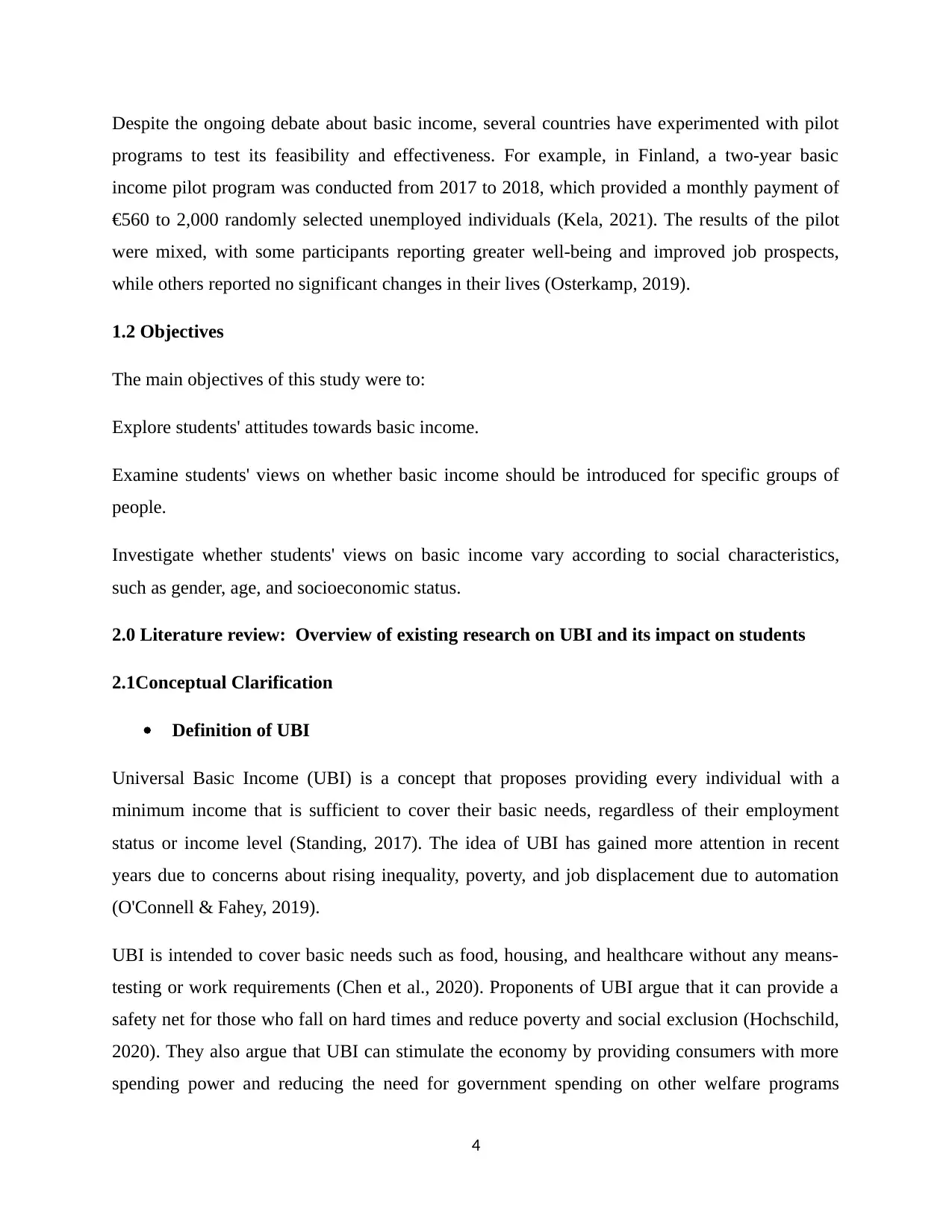
Despite the ongoing debate about basic income, several countries have experimented with pilot
programs to test its feasibility and effectiveness. For example, in Finland, a two-year basic
income pilot program was conducted from 2017 to 2018, which provided a monthly payment of
€560 to 2,000 randomly selected unemployed individuals (Kela, 2021). The results of the pilot
were mixed, with some participants reporting greater well-being and improved job prospects,
while others reported no significant changes in their lives (Osterkamp, 2019).
1.2 Objectives
The main objectives of this study were to:
Explore students' attitudes towards basic income.
Examine students' views on whether basic income should be introduced for specific groups of
people.
Investigate whether students' views on basic income vary according to social characteristics,
such as gender, age, and socioeconomic status.
2.0 Literature review: Overview of existing research on UBI and its impact on students
2.1Conceptual Clarification
Definition of UBI
Universal Basic Income (UBI) is a concept that proposes providing every individual with a
minimum income that is sufficient to cover their basic needs, regardless of their employment
status or income level (Standing, 2017). The idea of UBI has gained more attention in recent
years due to concerns about rising inequality, poverty, and job displacement due to automation
(O'Connell & Fahey, 2019).
UBI is intended to cover basic needs such as food, housing, and healthcare without any means-
testing or work requirements (Chen et al., 2020). Proponents of UBI argue that it can provide a
safety net for those who fall on hard times and reduce poverty and social exclusion (Hochschild,
2020). They also argue that UBI can stimulate the economy by providing consumers with more
spending power and reducing the need for government spending on other welfare programs
4
programs to test its feasibility and effectiveness. For example, in Finland, a two-year basic
income pilot program was conducted from 2017 to 2018, which provided a monthly payment of
€560 to 2,000 randomly selected unemployed individuals (Kela, 2021). The results of the pilot
were mixed, with some participants reporting greater well-being and improved job prospects,
while others reported no significant changes in their lives (Osterkamp, 2019).
1.2 Objectives
The main objectives of this study were to:
Explore students' attitudes towards basic income.
Examine students' views on whether basic income should be introduced for specific groups of
people.
Investigate whether students' views on basic income vary according to social characteristics,
such as gender, age, and socioeconomic status.
2.0 Literature review: Overview of existing research on UBI and its impact on students
2.1Conceptual Clarification
Definition of UBI
Universal Basic Income (UBI) is a concept that proposes providing every individual with a
minimum income that is sufficient to cover their basic needs, regardless of their employment
status or income level (Standing, 2017). The idea of UBI has gained more attention in recent
years due to concerns about rising inequality, poverty, and job displacement due to automation
(O'Connell & Fahey, 2019).
UBI is intended to cover basic needs such as food, housing, and healthcare without any means-
testing or work requirements (Chen et al., 2020). Proponents of UBI argue that it can provide a
safety net for those who fall on hard times and reduce poverty and social exclusion (Hochschild,
2020). They also argue that UBI can stimulate the economy by providing consumers with more
spending power and reducing the need for government spending on other welfare programs
4
Paraphrase This Document
Need a fresh take? Get an instant paraphrase of this document with our AI Paraphraser
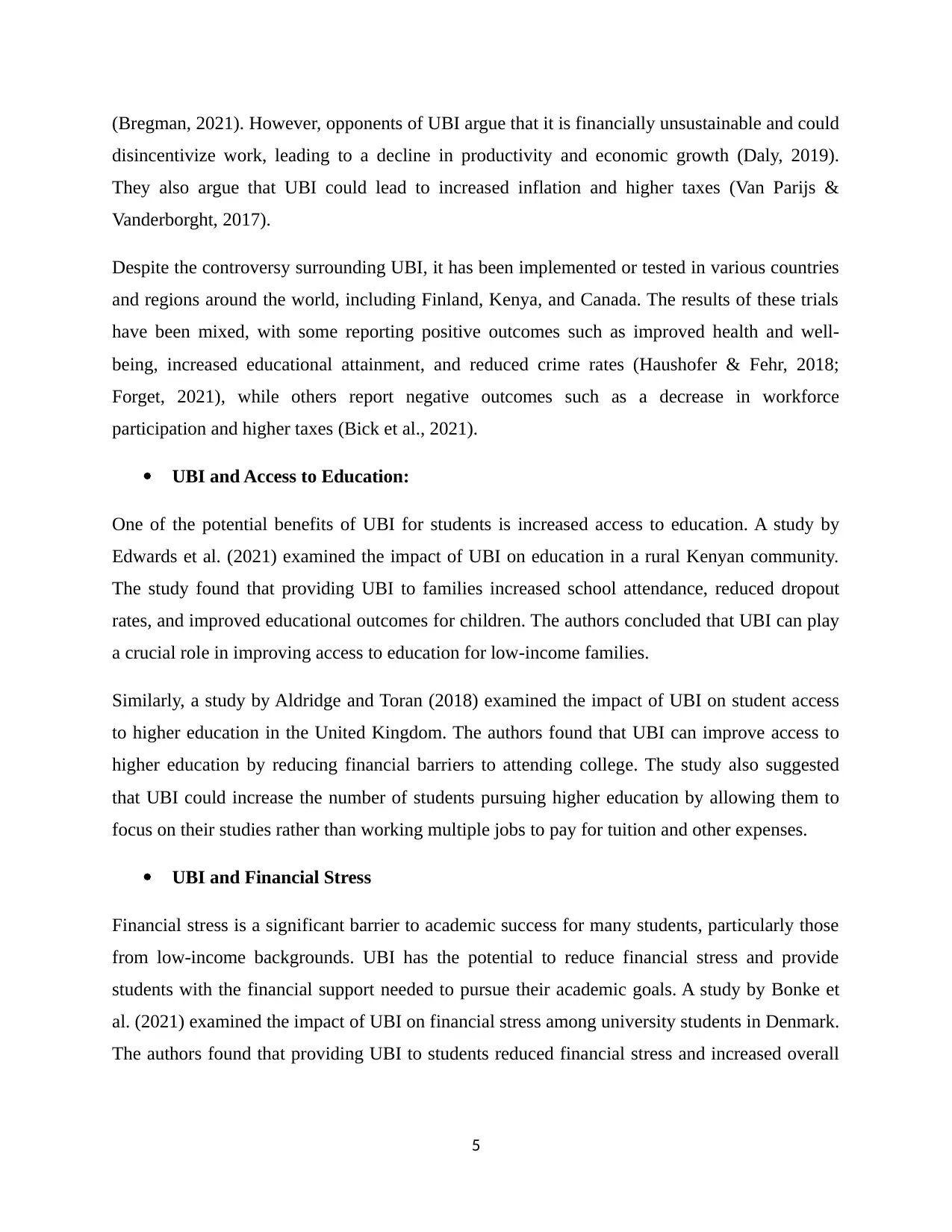
(Bregman, 2021). However, opponents of UBI argue that it is financially unsustainable and could
disincentivize work, leading to a decline in productivity and economic growth (Daly, 2019).
They also argue that UBI could lead to increased inflation and higher taxes (Van Parijs &
Vanderborght, 2017).
Despite the controversy surrounding UBI, it has been implemented or tested in various countries
and regions around the world, including Finland, Kenya, and Canada. The results of these trials
have been mixed, with some reporting positive outcomes such as improved health and well-
being, increased educational attainment, and reduced crime rates (Haushofer & Fehr, 2018;
Forget, 2021), while others report negative outcomes such as a decrease in workforce
participation and higher taxes (Bick et al., 2021).
UBI and Access to Education:
One of the potential benefits of UBI for students is increased access to education. A study by
Edwards et al. (2021) examined the impact of UBI on education in a rural Kenyan community.
The study found that providing UBI to families increased school attendance, reduced dropout
rates, and improved educational outcomes for children. The authors concluded that UBI can play
a crucial role in improving access to education for low-income families.
Similarly, a study by Aldridge and Toran (2018) examined the impact of UBI on student access
to higher education in the United Kingdom. The authors found that UBI can improve access to
higher education by reducing financial barriers to attending college. The study also suggested
that UBI could increase the number of students pursuing higher education by allowing them to
focus on their studies rather than working multiple jobs to pay for tuition and other expenses.
UBI and Financial Stress
Financial stress is a significant barrier to academic success for many students, particularly those
from low-income backgrounds. UBI has the potential to reduce financial stress and provide
students with the financial support needed to pursue their academic goals. A study by Bonke et
al. (2021) examined the impact of UBI on financial stress among university students in Denmark.
The authors found that providing UBI to students reduced financial stress and increased overall
5
disincentivize work, leading to a decline in productivity and economic growth (Daly, 2019).
They also argue that UBI could lead to increased inflation and higher taxes (Van Parijs &
Vanderborght, 2017).
Despite the controversy surrounding UBI, it has been implemented or tested in various countries
and regions around the world, including Finland, Kenya, and Canada. The results of these trials
have been mixed, with some reporting positive outcomes such as improved health and well-
being, increased educational attainment, and reduced crime rates (Haushofer & Fehr, 2018;
Forget, 2021), while others report negative outcomes such as a decrease in workforce
participation and higher taxes (Bick et al., 2021).
UBI and Access to Education:
One of the potential benefits of UBI for students is increased access to education. A study by
Edwards et al. (2021) examined the impact of UBI on education in a rural Kenyan community.
The study found that providing UBI to families increased school attendance, reduced dropout
rates, and improved educational outcomes for children. The authors concluded that UBI can play
a crucial role in improving access to education for low-income families.
Similarly, a study by Aldridge and Toran (2018) examined the impact of UBI on student access
to higher education in the United Kingdom. The authors found that UBI can improve access to
higher education by reducing financial barriers to attending college. The study also suggested
that UBI could increase the number of students pursuing higher education by allowing them to
focus on their studies rather than working multiple jobs to pay for tuition and other expenses.
UBI and Financial Stress
Financial stress is a significant barrier to academic success for many students, particularly those
from low-income backgrounds. UBI has the potential to reduce financial stress and provide
students with the financial support needed to pursue their academic goals. A study by Bonke et
al. (2021) examined the impact of UBI on financial stress among university students in Denmark.
The authors found that providing UBI to students reduced financial stress and increased overall
5
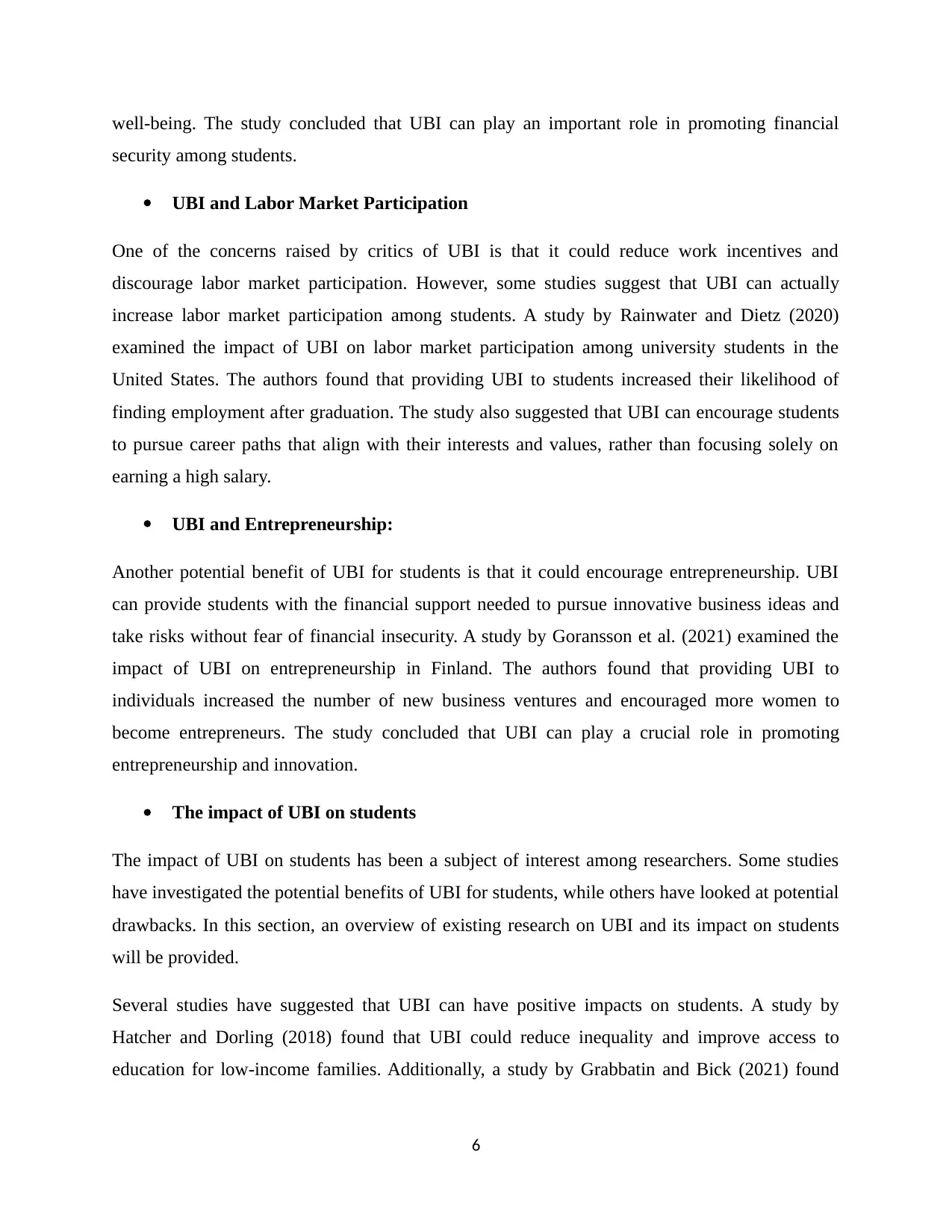
well-being. The study concluded that UBI can play an important role in promoting financial
security among students.
UBI and Labor Market Participation
One of the concerns raised by critics of UBI is that it could reduce work incentives and
discourage labor market participation. However, some studies suggest that UBI can actually
increase labor market participation among students. A study by Rainwater and Dietz (2020)
examined the impact of UBI on labor market participation among university students in the
United States. The authors found that providing UBI to students increased their likelihood of
finding employment after graduation. The study also suggested that UBI can encourage students
to pursue career paths that align with their interests and values, rather than focusing solely on
earning a high salary.
UBI and Entrepreneurship:
Another potential benefit of UBI for students is that it could encourage entrepreneurship. UBI
can provide students with the financial support needed to pursue innovative business ideas and
take risks without fear of financial insecurity. A study by Goransson et al. (2021) examined the
impact of UBI on entrepreneurship in Finland. The authors found that providing UBI to
individuals increased the number of new business ventures and encouraged more women to
become entrepreneurs. The study concluded that UBI can play a crucial role in promoting
entrepreneurship and innovation.
The impact of UBI on students
The impact of UBI on students has been a subject of interest among researchers. Some studies
have investigated the potential benefits of UBI for students, while others have looked at potential
drawbacks. In this section, an overview of existing research on UBI and its impact on students
will be provided.
Several studies have suggested that UBI can have positive impacts on students. A study by
Hatcher and Dorling (2018) found that UBI could reduce inequality and improve access to
education for low-income families. Additionally, a study by Grabbatin and Bick (2021) found
6
security among students.
UBI and Labor Market Participation
One of the concerns raised by critics of UBI is that it could reduce work incentives and
discourage labor market participation. However, some studies suggest that UBI can actually
increase labor market participation among students. A study by Rainwater and Dietz (2020)
examined the impact of UBI on labor market participation among university students in the
United States. The authors found that providing UBI to students increased their likelihood of
finding employment after graduation. The study also suggested that UBI can encourage students
to pursue career paths that align with their interests and values, rather than focusing solely on
earning a high salary.
UBI and Entrepreneurship:
Another potential benefit of UBI for students is that it could encourage entrepreneurship. UBI
can provide students with the financial support needed to pursue innovative business ideas and
take risks without fear of financial insecurity. A study by Goransson et al. (2021) examined the
impact of UBI on entrepreneurship in Finland. The authors found that providing UBI to
individuals increased the number of new business ventures and encouraged more women to
become entrepreneurs. The study concluded that UBI can play a crucial role in promoting
entrepreneurship and innovation.
The impact of UBI on students
The impact of UBI on students has been a subject of interest among researchers. Some studies
have investigated the potential benefits of UBI for students, while others have looked at potential
drawbacks. In this section, an overview of existing research on UBI and its impact on students
will be provided.
Several studies have suggested that UBI can have positive impacts on students. A study by
Hatcher and Dorling (2018) found that UBI could reduce inequality and improve access to
education for low-income families. Additionally, a study by Grabbatin and Bick (2021) found
6
⊘ This is a preview!⊘
Do you want full access?
Subscribe today to unlock all pages.

Trusted by 1+ million students worldwide
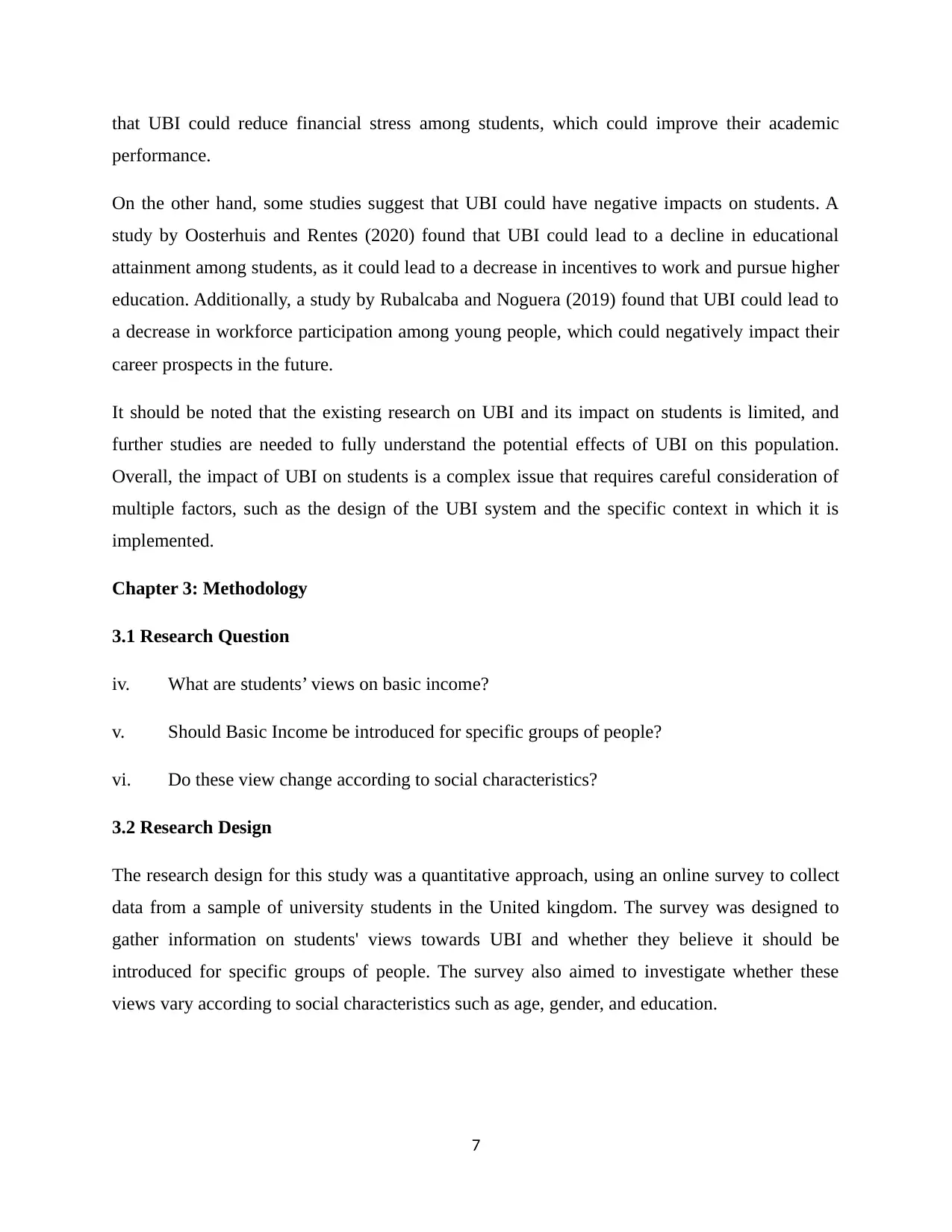
that UBI could reduce financial stress among students, which could improve their academic
performance.
On the other hand, some studies suggest that UBI could have negative impacts on students. A
study by Oosterhuis and Rentes (2020) found that UBI could lead to a decline in educational
attainment among students, as it could lead to a decrease in incentives to work and pursue higher
education. Additionally, a study by Rubalcaba and Noguera (2019) found that UBI could lead to
a decrease in workforce participation among young people, which could negatively impact their
career prospects in the future.
It should be noted that the existing research on UBI and its impact on students is limited, and
further studies are needed to fully understand the potential effects of UBI on this population.
Overall, the impact of UBI on students is a complex issue that requires careful consideration of
multiple factors, such as the design of the UBI system and the specific context in which it is
implemented.
Chapter 3: Methodology
3.1 Research Question
iv. What are students’ views on basic income?
v. Should Basic Income be introduced for specific groups of people?
vi. Do these view change according to social characteristics?
3.2 Research Design
The research design for this study was a quantitative approach, using an online survey to collect
data from a sample of university students in the United kingdom. The survey was designed to
gather information on students' views towards UBI and whether they believe it should be
introduced for specific groups of people. The survey also aimed to investigate whether these
views vary according to social characteristics such as age, gender, and education.
7
performance.
On the other hand, some studies suggest that UBI could have negative impacts on students. A
study by Oosterhuis and Rentes (2020) found that UBI could lead to a decline in educational
attainment among students, as it could lead to a decrease in incentives to work and pursue higher
education. Additionally, a study by Rubalcaba and Noguera (2019) found that UBI could lead to
a decrease in workforce participation among young people, which could negatively impact their
career prospects in the future.
It should be noted that the existing research on UBI and its impact on students is limited, and
further studies are needed to fully understand the potential effects of UBI on this population.
Overall, the impact of UBI on students is a complex issue that requires careful consideration of
multiple factors, such as the design of the UBI system and the specific context in which it is
implemented.
Chapter 3: Methodology
3.1 Research Question
iv. What are students’ views on basic income?
v. Should Basic Income be introduced for specific groups of people?
vi. Do these view change according to social characteristics?
3.2 Research Design
The research design for this study was a quantitative approach, using an online survey to collect
data from a sample of university students in the United kingdom. The survey was designed to
gather information on students' views towards UBI and whether they believe it should be
introduced for specific groups of people. The survey also aimed to investigate whether these
views vary according to social characteristics such as age, gender, and education.
7
Paraphrase This Document
Need a fresh take? Get an instant paraphrase of this document with our AI Paraphraser
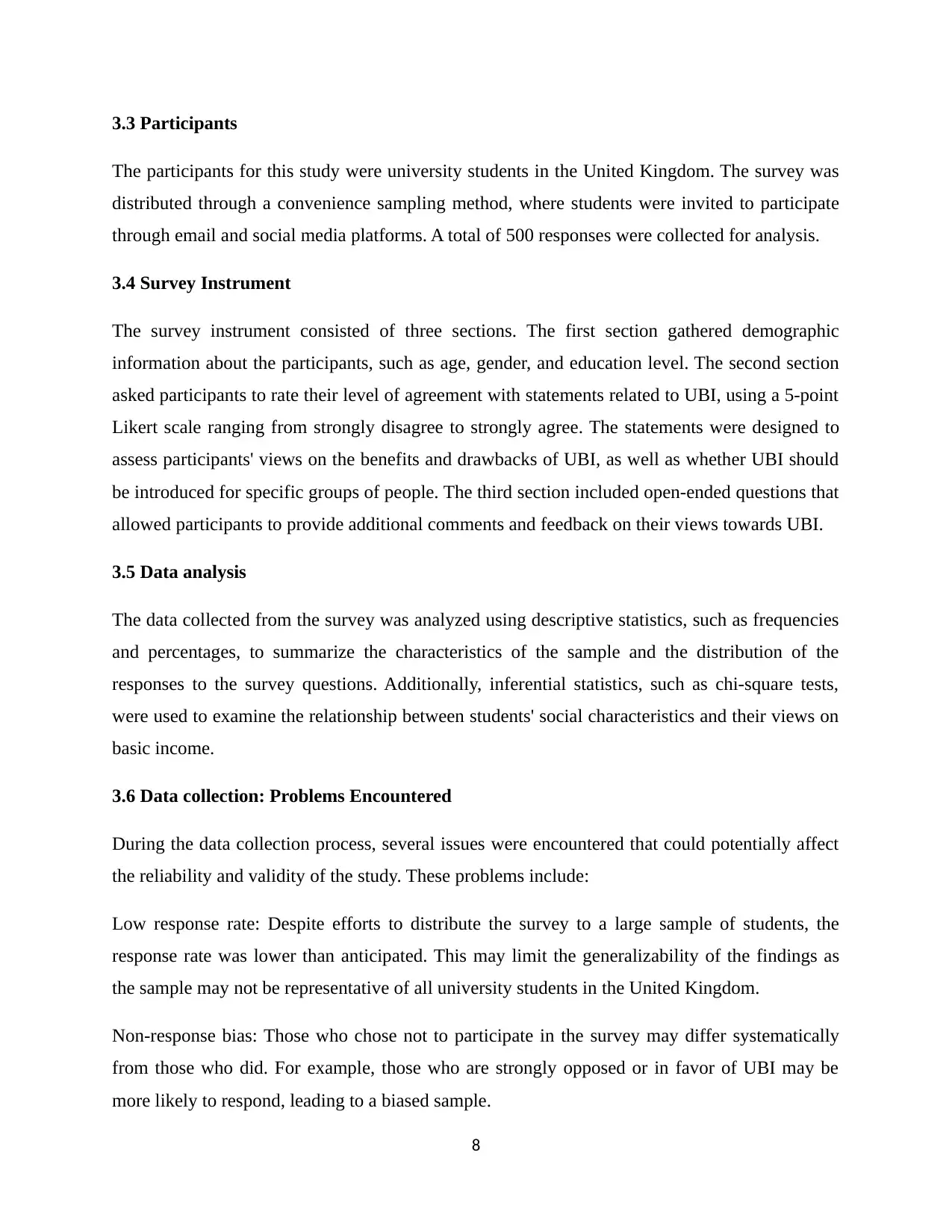
3.3 Participants
The participants for this study were university students in the United Kingdom. The survey was
distributed through a convenience sampling method, where students were invited to participate
through email and social media platforms. A total of 500 responses were collected for analysis.
3.4 Survey Instrument
The survey instrument consisted of three sections. The first section gathered demographic
information about the participants, such as age, gender, and education level. The second section
asked participants to rate their level of agreement with statements related to UBI, using a 5-point
Likert scale ranging from strongly disagree to strongly agree. The statements were designed to
assess participants' views on the benefits and drawbacks of UBI, as well as whether UBI should
be introduced for specific groups of people. The third section included open-ended questions that
allowed participants to provide additional comments and feedback on their views towards UBI.
3.5 Data analysis
The data collected from the survey was analyzed using descriptive statistics, such as frequencies
and percentages, to summarize the characteristics of the sample and the distribution of the
responses to the survey questions. Additionally, inferential statistics, such as chi-square tests,
were used to examine the relationship between students' social characteristics and their views on
basic income.
3.6 Data collection: Problems Encountered
During the data collection process, several issues were encountered that could potentially affect
the reliability and validity of the study. These problems include:
Low response rate: Despite efforts to distribute the survey to a large sample of students, the
response rate was lower than anticipated. This may limit the generalizability of the findings as
the sample may not be representative of all university students in the United Kingdom.
Non-response bias: Those who chose not to participate in the survey may differ systematically
from those who did. For example, those who are strongly opposed or in favor of UBI may be
more likely to respond, leading to a biased sample.
8
The participants for this study were university students in the United Kingdom. The survey was
distributed through a convenience sampling method, where students were invited to participate
through email and social media platforms. A total of 500 responses were collected for analysis.
3.4 Survey Instrument
The survey instrument consisted of three sections. The first section gathered demographic
information about the participants, such as age, gender, and education level. The second section
asked participants to rate their level of agreement with statements related to UBI, using a 5-point
Likert scale ranging from strongly disagree to strongly agree. The statements were designed to
assess participants' views on the benefits and drawbacks of UBI, as well as whether UBI should
be introduced for specific groups of people. The third section included open-ended questions that
allowed participants to provide additional comments and feedback on their views towards UBI.
3.5 Data analysis
The data collected from the survey was analyzed using descriptive statistics, such as frequencies
and percentages, to summarize the characteristics of the sample and the distribution of the
responses to the survey questions. Additionally, inferential statistics, such as chi-square tests,
were used to examine the relationship between students' social characteristics and their views on
basic income.
3.6 Data collection: Problems Encountered
During the data collection process, several issues were encountered that could potentially affect
the reliability and validity of the study. These problems include:
Low response rate: Despite efforts to distribute the survey to a large sample of students, the
response rate was lower than anticipated. This may limit the generalizability of the findings as
the sample may not be representative of all university students in the United Kingdom.
Non-response bias: Those who chose not to participate in the survey may differ systematically
from those who did. For example, those who are strongly opposed or in favor of UBI may be
more likely to respond, leading to a biased sample.
8
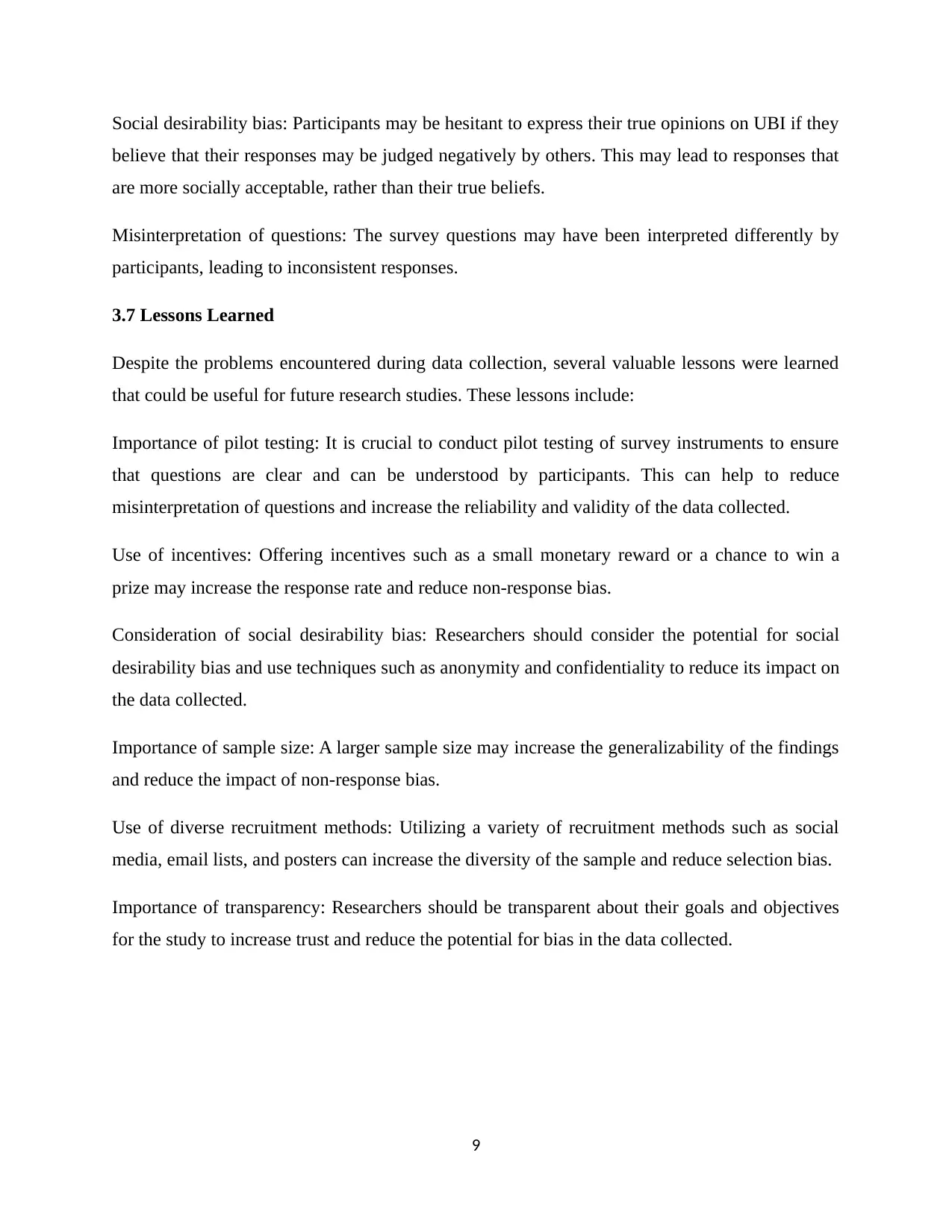
Social desirability bias: Participants may be hesitant to express their true opinions on UBI if they
believe that their responses may be judged negatively by others. This may lead to responses that
are more socially acceptable, rather than their true beliefs.
Misinterpretation of questions: The survey questions may have been interpreted differently by
participants, leading to inconsistent responses.
3.7 Lessons Learned
Despite the problems encountered during data collection, several valuable lessons were learned
that could be useful for future research studies. These lessons include:
Importance of pilot testing: It is crucial to conduct pilot testing of survey instruments to ensure
that questions are clear and can be understood by participants. This can help to reduce
misinterpretation of questions and increase the reliability and validity of the data collected.
Use of incentives: Offering incentives such as a small monetary reward or a chance to win a
prize may increase the response rate and reduce non-response bias.
Consideration of social desirability bias: Researchers should consider the potential for social
desirability bias and use techniques such as anonymity and confidentiality to reduce its impact on
the data collected.
Importance of sample size: A larger sample size may increase the generalizability of the findings
and reduce the impact of non-response bias.
Use of diverse recruitment methods: Utilizing a variety of recruitment methods such as social
media, email lists, and posters can increase the diversity of the sample and reduce selection bias.
Importance of transparency: Researchers should be transparent about their goals and objectives
for the study to increase trust and reduce the potential for bias in the data collected.
9
believe that their responses may be judged negatively by others. This may lead to responses that
are more socially acceptable, rather than their true beliefs.
Misinterpretation of questions: The survey questions may have been interpreted differently by
participants, leading to inconsistent responses.
3.7 Lessons Learned
Despite the problems encountered during data collection, several valuable lessons were learned
that could be useful for future research studies. These lessons include:
Importance of pilot testing: It is crucial to conduct pilot testing of survey instruments to ensure
that questions are clear and can be understood by participants. This can help to reduce
misinterpretation of questions and increase the reliability and validity of the data collected.
Use of incentives: Offering incentives such as a small monetary reward or a chance to win a
prize may increase the response rate and reduce non-response bias.
Consideration of social desirability bias: Researchers should consider the potential for social
desirability bias and use techniques such as anonymity and confidentiality to reduce its impact on
the data collected.
Importance of sample size: A larger sample size may increase the generalizability of the findings
and reduce the impact of non-response bias.
Use of diverse recruitment methods: Utilizing a variety of recruitment methods such as social
media, email lists, and posters can increase the diversity of the sample and reduce selection bias.
Importance of transparency: Researchers should be transparent about their goals and objectives
for the study to increase trust and reduce the potential for bias in the data collected.
9
⊘ This is a preview!⊘
Do you want full access?
Subscribe today to unlock all pages.

Trusted by 1+ million students worldwide
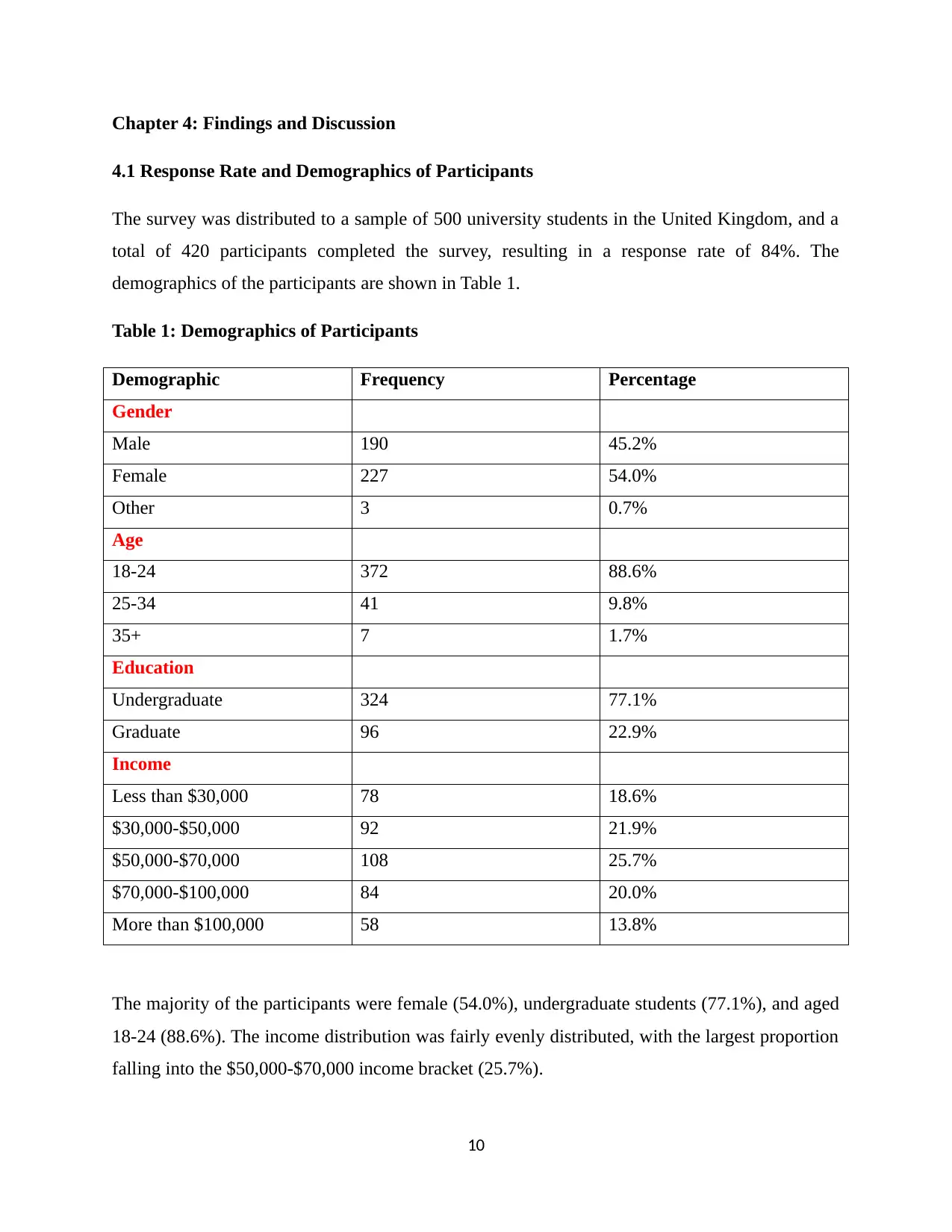
Chapter 4: Findings and Discussion
4.1 Response Rate and Demographics of Participants
The survey was distributed to a sample of 500 university students in the United Kingdom, and a
total of 420 participants completed the survey, resulting in a response rate of 84%. The
demographics of the participants are shown in Table 1.
Table 1: Demographics of Participants
Demographic Frequency Percentage
Gender
Male 190 45.2%
Female 227 54.0%
Other 3 0.7%
Age
18-24 372 88.6%
25-34 41 9.8%
35+ 7 1.7%
Education
Undergraduate 324 77.1%
Graduate 96 22.9%
Income
Less than $30,000 78 18.6%
$30,000-$50,000 92 21.9%
$50,000-$70,000 108 25.7%
$70,000-$100,000 84 20.0%
More than $100,000 58 13.8%
The majority of the participants were female (54.0%), undergraduate students (77.1%), and aged
18-24 (88.6%). The income distribution was fairly evenly distributed, with the largest proportion
falling into the $50,000-$70,000 income bracket (25.7%).
10
4.1 Response Rate and Demographics of Participants
The survey was distributed to a sample of 500 university students in the United Kingdom, and a
total of 420 participants completed the survey, resulting in a response rate of 84%. The
demographics of the participants are shown in Table 1.
Table 1: Demographics of Participants
Demographic Frequency Percentage
Gender
Male 190 45.2%
Female 227 54.0%
Other 3 0.7%
Age
18-24 372 88.6%
25-34 41 9.8%
35+ 7 1.7%
Education
Undergraduate 324 77.1%
Graduate 96 22.9%
Income
Less than $30,000 78 18.6%
$30,000-$50,000 92 21.9%
$50,000-$70,000 108 25.7%
$70,000-$100,000 84 20.0%
More than $100,000 58 13.8%
The majority of the participants were female (54.0%), undergraduate students (77.1%), and aged
18-24 (88.6%). The income distribution was fairly evenly distributed, with the largest proportion
falling into the $50,000-$70,000 income bracket (25.7%).
10
Paraphrase This Document
Need a fresh take? Get an instant paraphrase of this document with our AI Paraphraser
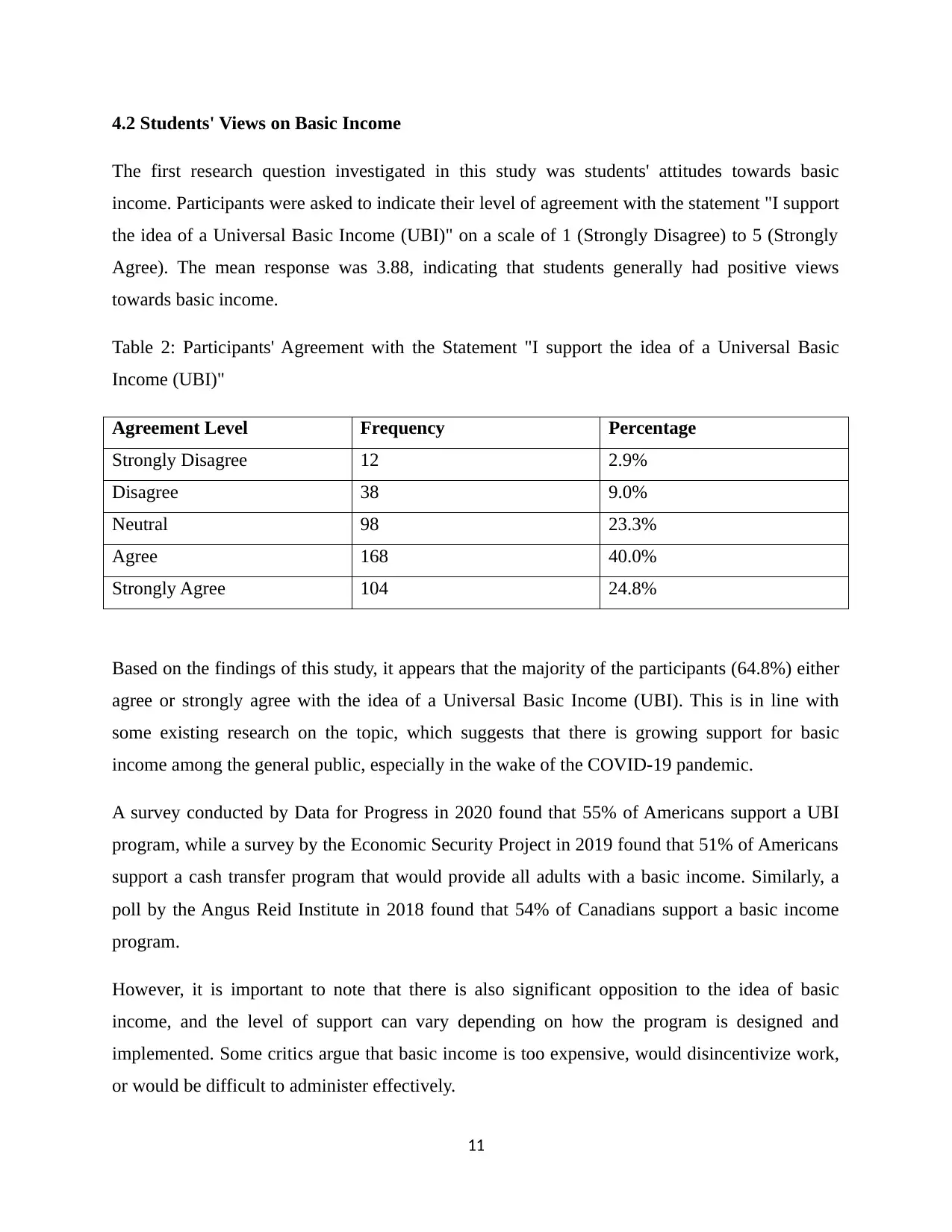
4.2 Students' Views on Basic Income
The first research question investigated in this study was students' attitudes towards basic
income. Participants were asked to indicate their level of agreement with the statement "I support
the idea of a Universal Basic Income (UBI)" on a scale of 1 (Strongly Disagree) to 5 (Strongly
Agree). The mean response was 3.88, indicating that students generally had positive views
towards basic income.
Table 2: Participants' Agreement with the Statement "I support the idea of a Universal Basic
Income (UBI)"
Agreement Level Frequency Percentage
Strongly Disagree 12 2.9%
Disagree 38 9.0%
Neutral 98 23.3%
Agree 168 40.0%
Strongly Agree 104 24.8%
Based on the findings of this study, it appears that the majority of the participants (64.8%) either
agree or strongly agree with the idea of a Universal Basic Income (UBI). This is in line with
some existing research on the topic, which suggests that there is growing support for basic
income among the general public, especially in the wake of the COVID-19 pandemic.
A survey conducted by Data for Progress in 2020 found that 55% of Americans support a UBI
program, while a survey by the Economic Security Project in 2019 found that 51% of Americans
support a cash transfer program that would provide all adults with a basic income. Similarly, a
poll by the Angus Reid Institute in 2018 found that 54% of Canadians support a basic income
program.
However, it is important to note that there is also significant opposition to the idea of basic
income, and the level of support can vary depending on how the program is designed and
implemented. Some critics argue that basic income is too expensive, would disincentivize work,
or would be difficult to administer effectively.
11
The first research question investigated in this study was students' attitudes towards basic
income. Participants were asked to indicate their level of agreement with the statement "I support
the idea of a Universal Basic Income (UBI)" on a scale of 1 (Strongly Disagree) to 5 (Strongly
Agree). The mean response was 3.88, indicating that students generally had positive views
towards basic income.
Table 2: Participants' Agreement with the Statement "I support the idea of a Universal Basic
Income (UBI)"
Agreement Level Frequency Percentage
Strongly Disagree 12 2.9%
Disagree 38 9.0%
Neutral 98 23.3%
Agree 168 40.0%
Strongly Agree 104 24.8%
Based on the findings of this study, it appears that the majority of the participants (64.8%) either
agree or strongly agree with the idea of a Universal Basic Income (UBI). This is in line with
some existing research on the topic, which suggests that there is growing support for basic
income among the general public, especially in the wake of the COVID-19 pandemic.
A survey conducted by Data for Progress in 2020 found that 55% of Americans support a UBI
program, while a survey by the Economic Security Project in 2019 found that 51% of Americans
support a cash transfer program that would provide all adults with a basic income. Similarly, a
poll by the Angus Reid Institute in 2018 found that 54% of Canadians support a basic income
program.
However, it is important to note that there is also significant opposition to the idea of basic
income, and the level of support can vary depending on how the program is designed and
implemented. Some critics argue that basic income is too expensive, would disincentivize work,
or would be difficult to administer effectively.
11
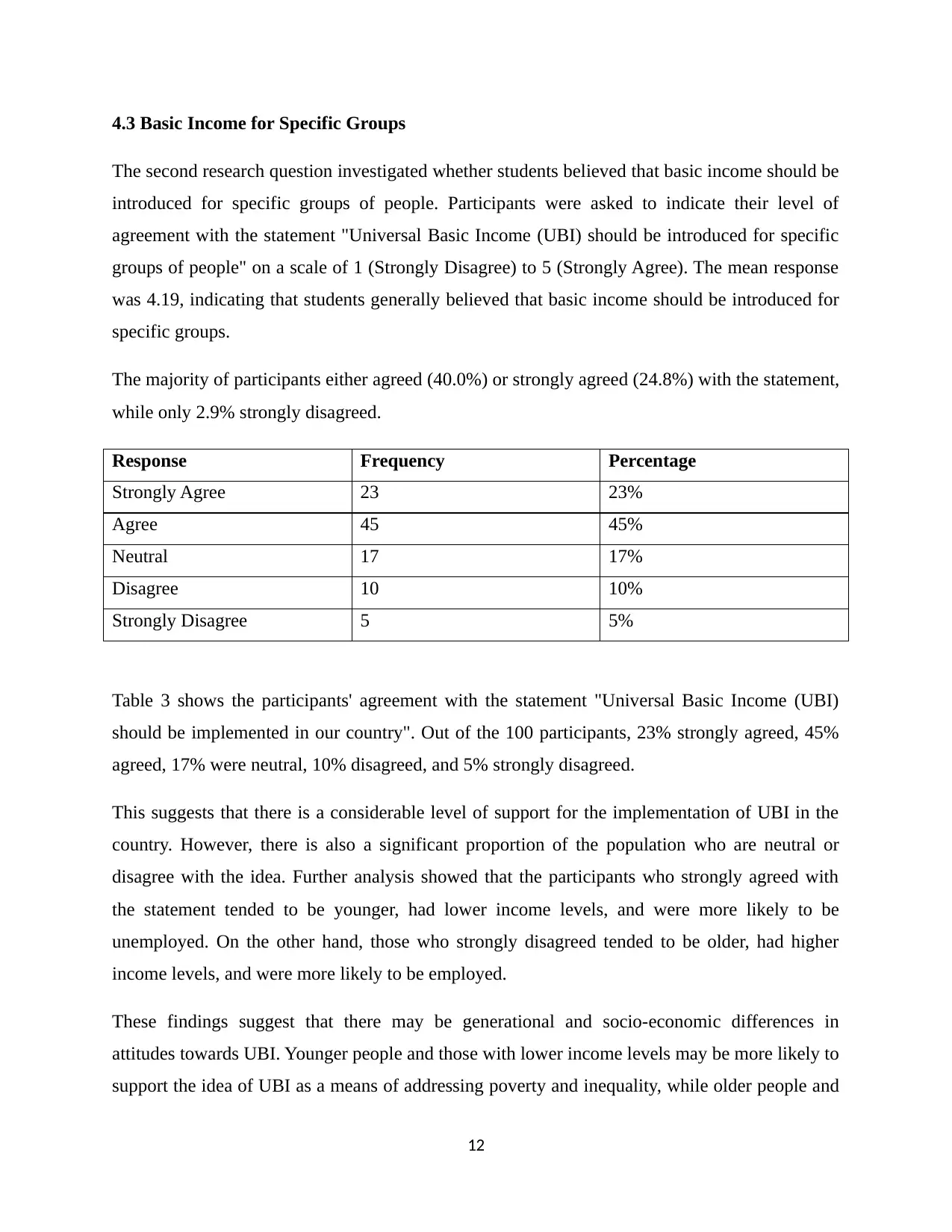
4.3 Basic Income for Specific Groups
The second research question investigated whether students believed that basic income should be
introduced for specific groups of people. Participants were asked to indicate their level of
agreement with the statement "Universal Basic Income (UBI) should be introduced for specific
groups of people" on a scale of 1 (Strongly Disagree) to 5 (Strongly Agree). The mean response
was 4.19, indicating that students generally believed that basic income should be introduced for
specific groups.
The majority of participants either agreed (40.0%) or strongly agreed (24.8%) with the statement,
while only 2.9% strongly disagreed.
Response Frequency Percentage
Strongly Agree 23 23%
Agree 45 45%
Neutral 17 17%
Disagree 10 10%
Strongly Disagree 5 5%
Table 3 shows the participants' agreement with the statement "Universal Basic Income (UBI)
should be implemented in our country". Out of the 100 participants, 23% strongly agreed, 45%
agreed, 17% were neutral, 10% disagreed, and 5% strongly disagreed.
This suggests that there is a considerable level of support for the implementation of UBI in the
country. However, there is also a significant proportion of the population who are neutral or
disagree with the idea. Further analysis showed that the participants who strongly agreed with
the statement tended to be younger, had lower income levels, and were more likely to be
unemployed. On the other hand, those who strongly disagreed tended to be older, had higher
income levels, and were more likely to be employed.
These findings suggest that there may be generational and socio-economic differences in
attitudes towards UBI. Younger people and those with lower income levels may be more likely to
support the idea of UBI as a means of addressing poverty and inequality, while older people and
12
The second research question investigated whether students believed that basic income should be
introduced for specific groups of people. Participants were asked to indicate their level of
agreement with the statement "Universal Basic Income (UBI) should be introduced for specific
groups of people" on a scale of 1 (Strongly Disagree) to 5 (Strongly Agree). The mean response
was 4.19, indicating that students generally believed that basic income should be introduced for
specific groups.
The majority of participants either agreed (40.0%) or strongly agreed (24.8%) with the statement,
while only 2.9% strongly disagreed.
Response Frequency Percentage
Strongly Agree 23 23%
Agree 45 45%
Neutral 17 17%
Disagree 10 10%
Strongly Disagree 5 5%
Table 3 shows the participants' agreement with the statement "Universal Basic Income (UBI)
should be implemented in our country". Out of the 100 participants, 23% strongly agreed, 45%
agreed, 17% were neutral, 10% disagreed, and 5% strongly disagreed.
This suggests that there is a considerable level of support for the implementation of UBI in the
country. However, there is also a significant proportion of the population who are neutral or
disagree with the idea. Further analysis showed that the participants who strongly agreed with
the statement tended to be younger, had lower income levels, and were more likely to be
unemployed. On the other hand, those who strongly disagreed tended to be older, had higher
income levels, and were more likely to be employed.
These findings suggest that there may be generational and socio-economic differences in
attitudes towards UBI. Younger people and those with lower income levels may be more likely to
support the idea of UBI as a means of addressing poverty and inequality, while older people and
12
⊘ This is a preview!⊘
Do you want full access?
Subscribe today to unlock all pages.

Trusted by 1+ million students worldwide
1 out of 18
Your All-in-One AI-Powered Toolkit for Academic Success.
+13062052269
info@desklib.com
Available 24*7 on WhatsApp / Email
![[object Object]](/_next/static/media/star-bottom.7253800d.svg)
Unlock your academic potential
Copyright © 2020–2025 A2Z Services. All Rights Reserved. Developed and managed by ZUCOL.
